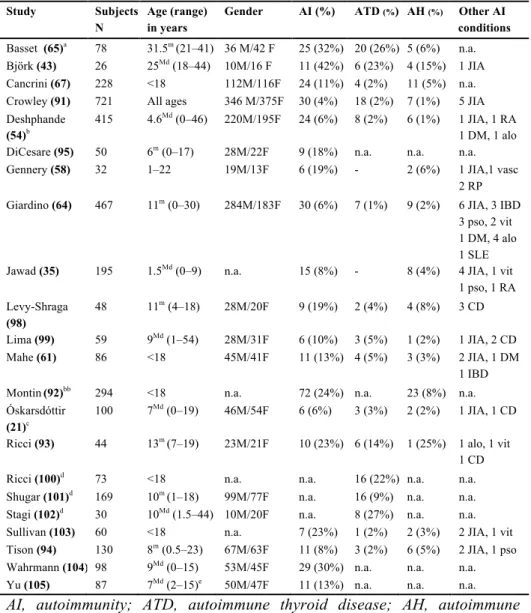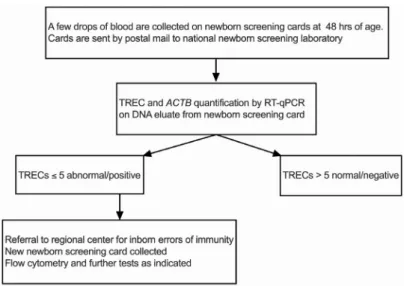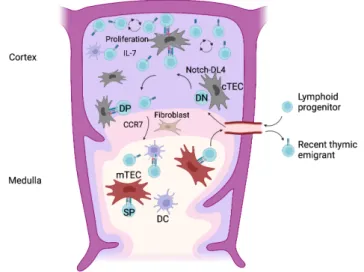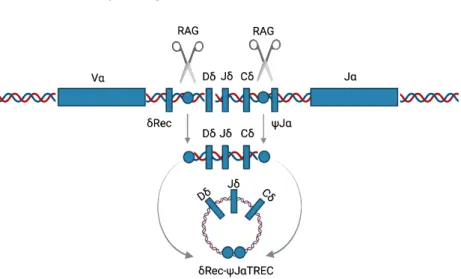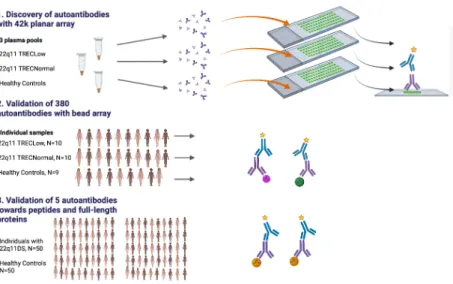Subjects with low TREC counts (22q11Low, N=10), normal TREC counts (22q11Normal, N=10), and matched healthy controls (N=10) were followed up, including quantification of TRECs, flow cytometry for characterization of subsets of lymphocytes, deep sequencing of T cell receptor repertoires and PCR for assessment of telomere lengths (Paper II). Results A significant proportion of babies with 22q11DS had an abnormal number of TRECs at birth (Paper I).
The 22q11.2 deletion syndrome
The long-term consequences of early senescence of the immune system in individuals with 22q11DS remain to be elucidated. A British retrospective report of 467 individuals with 22q11DS (mostly children) from a single center reported allergic manifestations in 24%, as well as an association with low levels of IgM (64).
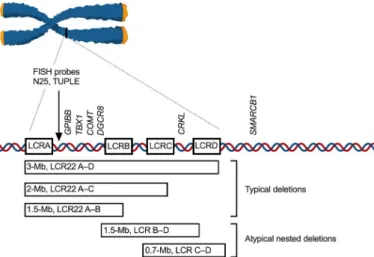
Newborn screening with TRECs
Population-based newborn screening with the TREC assay was initiated in Wisconsin in 2008, and a decade later all states in the United States had implemented TREC screening programs (125, 126). When the first TREC screening programs from the United States reported their results, it was clear that the sensitivity for detecting SCID was close. It was also clear that TREC screening assays identified cases of T-lymphopenia with origins other than typical SCID.
Based on the prevailing knowledge that complete athymia and subsequent lack of T cells are present in less than 1% of infants with 22q11DS (31), the numbers of infants with 22q11DS identified in TREC screening programs are perhaps surprising. The TREC screening programs for newborns operating in different countries differ in several aspects, for example regarding the methodology used for the TREC test, the applied cut-off points and the follow-up algorithms. Absent or very low numbers of TRECs on the newborn screening chart in a term infant, in a situation with normal amplification of the housekeeping gene, is highly indicative of SCID (126).
The TREC newborn screening program in Norway is unique in that it has integrated next-generation sequencing (NGS) of a gene panel into the newborn screening card as a second-tier test.
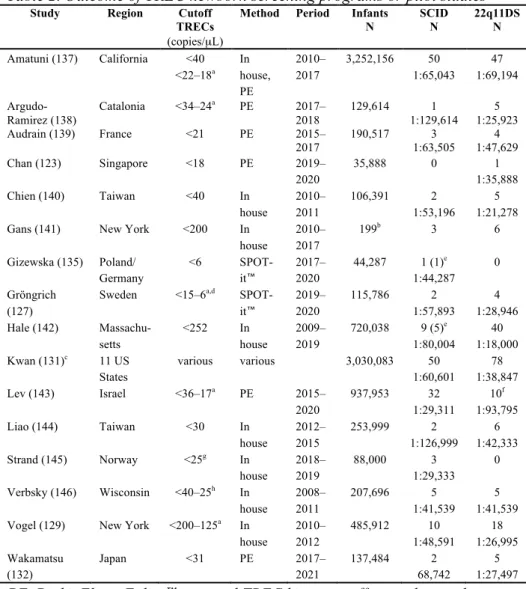
The thymus
Further insights into the importance of the thymus have come from observations of rare human conditions. The pharyngeal arches are five paired structures located on either side of the pharyngeal foregut in the human embryo. Schematic illustration of a human embryo on the left, with a cross-section of the pharyngeal region on the right.
Hox genes in the pharyngeal region: how Hoxa3 controls early embryonic development of pharyngeal organs. In the second stage of thymic organogenesis, the transcription factor Forkhead box N1 (Foxn1) dictates the patterning of the thymic epithelium. SjTRECs generated during α-chain recombination (δRec-ψJα TRECs) are particularly suitable as biomarkers for the generation of naïve T cells used in newborn screening (165).
Negative selection results in the deletion of most of the thymocytes that have high affinity TCRs against self-peptide-MHC complexes, while only a low number of T lymphocytes exit the thymus as naïve effector T cells.
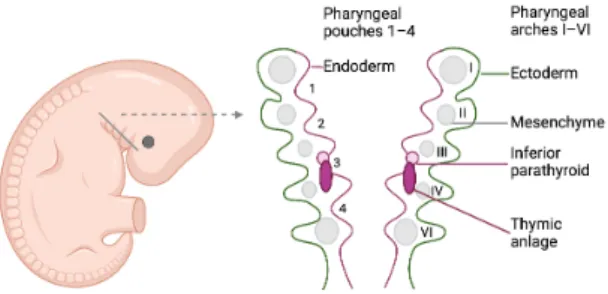
Thymus defects
In most cases, there are T lymphocytes present in the peripheral blood, reflecting a poor thymic decline and the presence of ectopic thymic tissue (21). TBX1 is expressed in the pharyngeal epithelium and pharyngeal mesoderm, but not in the neural crest ( 180 ). Retinoic acid interacts with TBX1 and plays a role in the formation of pharyngeal arch and third pharyngeal pouch arteries (154).
CHD7 is important for the formation of the pharyngeal arches, where it is expressed in the mesoderm and endoderm. Bi-allelic mutations in the tetratricopeptide repeat domain-7A (TTC7A) gene lead to intestinal atresia and combined immunodeficiency (213). In classic forms of SCID, T cells are usually absent and the thymus does not develop.
The most obvious iatrogenic injury to the thymus is thymectomy, especially if done in the neonatal period.
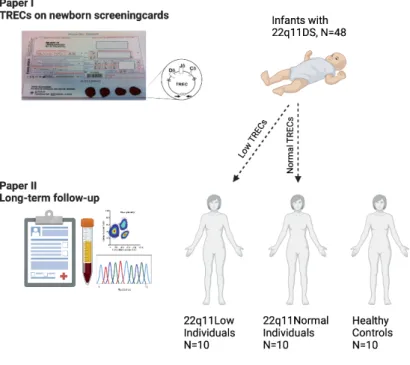
Paper I
For Papers I-II, participants were recruited from Queen Silvia Children's Hospital in Gothenburg, a national reference center for pediatric immunology and pediatric cardiac surgery. Children under the age of 18 with a suspected or confirmed diagnosis of 22q11DS are usually referred to the pediatric immunology outpatient clinic by the subspecialists in the partnership or from outpatient clinics in the region. An extensive cohort was recruited for Paper III, mainly from Queen Silvia Children's Hospital, Gothenburg, although individuals with 22q11DS seen at Halland Hospital, Halmstad were also invited to participate.
In Sweden, all newborn screening cards are sent for analysis to the centralized laboratory of Karolinska University Hospital in Solna. A triplex RT-qPCR assay was used for the quantification of TRECs, KRECs and the housekeeping gene ACTB from the original newborn screening charts. An additional RT-qPCR was performed on the same DNA eluate from the dried blood spots, as described in article I, to quantify the expression levels of TBX1 and the reference gene PTBP1.
The absolute numbers of T-lymphocytes (CD3+), T-helper lymphocytes (CD4+), cytotoxic T-lymphocytes (CD8+), and B-lymphocytes (CD19+) were determined by standard flow cytometry methods at the time of diagnosis, and the results were obtained retrospectively from the medical charts .
Paper II
This cutoff was used in a pilot study prior to population-based newborn screening in Sweden (147). Based on the results of the TREC test on the newborn screening cards in Document I, we included 10 individuals with the lowest (22q11Low) or highest (22q11Normal) TREC and 10 age- and sex-matched healthy controls (Figure 6). . Briefly, the appearance of the same clone (with identical V gene and CDR3 amino acid sequence) in replicate samples indicates higher clonality.
Details of the procedure, including definition of cell types, staining and gating strategy used for flow cytometry-based sorting of cells, are provided in Paper II. A multivariate discriminant analysis (orthogonal projection to latent structures using partial least squares discriminant analysis, OPLS-DA) based on the entire data set was used to screen for differences between. The Kruskal-Wallis test, followed by Dunn's correction, was used for univariate comparisons between groups, except for comparisons of telomere lengths, where a linear mixed model was used.
The Kruskal-Wallis test, followed by Dunn's correction, was used for univariate comparisons between groups, except for comparisons of telomere length, for which a linear mixed model was applied.
Paper III
The planar array, which was developed as part of the Human Protein Atlas project, had previously been validated for high-throughput detection of potential autoantibodies (244, 245). Five antigens were selected for further validation, based on their high reactivity frequencies in the 22q11DS samples and the high intensity levels of the reactive signals. The main limitation of Paper II was the low number of participants, which provided insufficient power in some of the univariate statistical analyses.
Despite the low numbers, most of the variables pointed in the same direction, toward persistent impairment of thymopoiesis and premature immunosenescence in the individuals with 22q11DS and low numbers of TRECs at birth. These findings were reinforced by the clear separation of the groups in the multivariate analysis. The main concern of the exploratory method used in Paper III was the use of peptide fragments instead of full-length proteins.
A major strength of the planar array is its high density, covering approximately 94% of the human proteome (244, 248).
Paper I
Most subjects had a heart defect (81%), while 40% had hypocalcaemia during the first year of life. In all, 37 of the 88 eligible individuals with 22q11DS did not respond to the invitation, which was mailed once. The babies with 22q11DS had significantly lower numbers of TRECs, compared to the prospectively screened anonymous newborns.
KREC numbers did not differ between the babies with 22q11DS and anonymous newborns (Figure 8). Number of TRECs and KRECs per µl of blood from the newborn screening chart, in infants with 22q11DS (red dots), infants with innate immunity defects (black dots), and in anonymous newborns (white dots). When infants with 22q11DS and an abnormal number of TRECs were compared to the 22q11DS group with a normal number of TRECs, the absolute number of cytotoxic T-lymphocytes at diagnosis was significantly lower (400x106/L vs. 580x106/L).
Impact of abnormal numbers of TRECs on the clinical course A greater proportion of the infants with 22q11DS and abnormal numbers of TRECs had significant viral infections during the first year of life (67%), compared to infants with 22q11DS and normal numbers of TRECs ( 38 %).
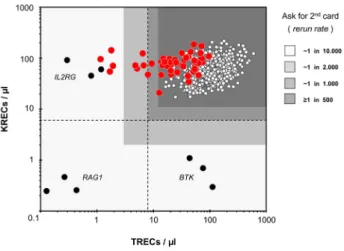
Paper II
Autoimmunity was noted in 3 of 10 individuals in the 22q11Low group compared with 1 of 10 in the 22q11Normal group and in the healthy controls. When TRECs were quantified in whole blood at follow-up, TREC numbers were significantly lower in the 22q11Low individuals compared to both the healthy controls and the 22q11Normal group (Figure 9a). At follow-up, the absolute numbers and proportions of T helper cells were significantly lower in the 22q11Low group compared to the healthy controls, and these differences were most evident for the naïve T helper cells (Figure 9 b,c).
The absolute counts and proportions of naïve cytotoxic T cells were lower in the 22q11Low group, compared to the healthy controls (Figure 9 d, e). When comparing the 22q11Low group and the 22q11Normal group, there were no differences in the absolute counts of naive T-helper lymphocytes or naive cytotoxic T cells, although the 22q11Low group showed reduced proportions of naive T-helper cells in comparison with the 22q11Normal group ( Figure 9 b-e). When the 22q11Low group was compared with the healthy controls and with the 22q11Normal individuals, skewed usage towards the dominant V genes 19, 12-3 and 29-1 was noted (Figure 10).
When comparing the 22q11Low group with the healthy controls, the relative telomere lengths of the naive cytotoxic T cells were shorter and there was a trend towards higher clonality scores.
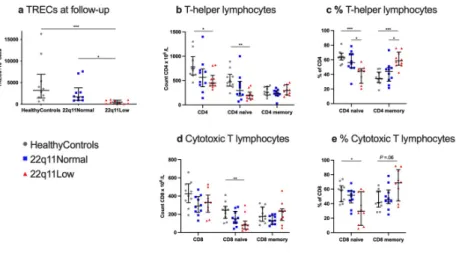
Paper III
In a similar retrospective study of infants with 22q11DS performed in Norway, Gul et al. Driscoll DA, Spinner NB, Budarf ML, McDonald-McGinn DM, Zackai EH, Goldberg RB, et al.
